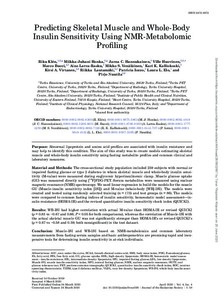Predicting Skeletal Muscle and Whole-Body Insulin Sensitivity Using NMR-Metabolomic Profiling
Latva-Rasku A; Nuutila P; Hannukainen JC; Venäläinen MS; Klén R; Virtanen KA; Lautamäki R; Iozzo P; Kalliokoski KK; Bucci M; Honka MJ; Huovinen V; Elo LL
Predicting Skeletal Muscle and Whole-Body Insulin Sensitivity Using NMR-Metabolomic Profiling
Latva-Rasku A
Nuutila P
Hannukainen JC
Venäläinen MS
Klén R
Virtanen KA
Lautamäki R
Iozzo P
Kalliokoski KK
Bucci M
Honka MJ
Huovinen V
Elo LL
ENDOCRINE SOC
Julkaisun pysyvä osoite on:
https://urn.fi/URN:NBN:fi-fe2021042823590
https://urn.fi/URN:NBN:fi-fe2021042823590
Tiivistelmä
Purpose: Abnormal lipoprotein and amino acid profiles are associated with insulin resistance and may help to identify this condition. The aim of this study was to create models estimating skeletal muscle and whole-body insulin sensitivity using fasting metabolite profiles and common clinical and laboratory measures.Material and Methods: The cross-sectional study population included 259 subjects with normal or impaired fasting glucose or type 2 diabetes in whom skeletal muscle and whole-body insulin sensitivity (M-value) were measured during euglycemic hyperinsulinemic clamp. Muscle glucose uptake (GU) was measured directly using [F-18]FDG-PET. Serum metabolites were measured using nuclear magnetic resonance (NMR) spectroscopy. We used linear regression to build the models for the muscle GU (Muscle-insulin sensitivity index [ISI]) and M-value (whole-body [WB]-ISI). The models were created and tested using randomly selected training (n = 173) and test groups (n = 86). The models were compared to common fasting indices of insulin sensitivity, homeostatic model assessment-insulin resistance (HOMA-IR) and the revised quantitative insulin sensitivity check index (QUICKI).Results: WB-ISI had higher correlation with actual M-value than HOMA-IR or revised QUICKI (rho = 0.83 vs -0.67 and 0.66; P < 0.05 for both comparisons), whereas the correlation of Muscle-ISI with the actual skeletal muscle GU was not significantly stronger than HOMA-IR's or revised QUICKI's (rho = 0.67 vs -0.58 and 0.59; both nonsignificant) in the test dataset.Conclusion: Muscle-ISI and WB-ISI based on NMR-metabolomics and common laboratory measurements from fasting serum samples and basic anthropometrics are promising rapid and inexpensive tools for determining insulin sensitivity in at-risk individuals. (C) Endocrine Society 2020.
Kokoelmat
- Rinnakkaistallenteet [19207]
